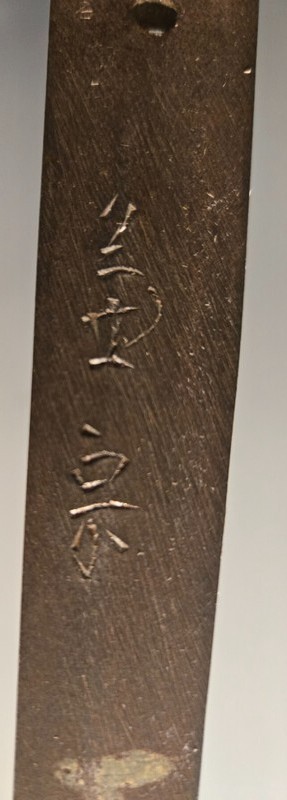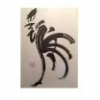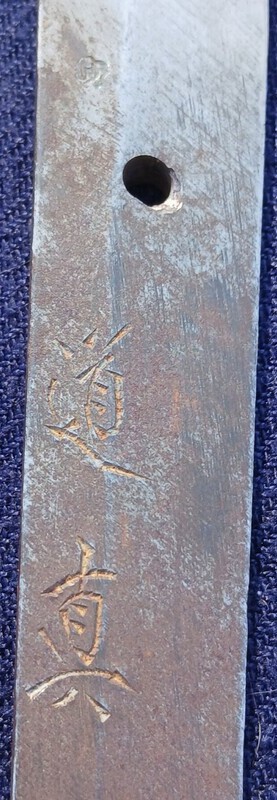-
Posts
830 -
Joined
-
Last visited
-
Days Won
10
Content Type
Profiles
Forums
Events
Store
Downloads
Gallery
Posts posted by mecox
-
-
Erik, from Markus Sesko , Swordsmiths of Japan (2015):
KANESAKI (兼先), Tenbun (天文, 1532-1555), Inaba – “Kaneyoshi yori godai Kanesaki sandai saku” (従兼吉五代兼先三代作, “third generation Kanesaki, fifth generation after Kaneyoshi”), “Inshū-jū Fujiwara Kanesaki” (因州住藤原兼先), “Kanesaki saku” (兼先作).
KANESAKI (兼先), 1st gen., Keichō (慶長, 1596-1615), Bizen/Inaba – “Inshū-jū Kanesaki” (因州住兼先), “Kanesaki” (兼先), real name Heki Sō´emon (日置惣右郎), son of Heki Isuke (日置伊助), he came originally from Bizen province, the moving to Tottori (鳥取) to Inaba province took place in the ninth year of Kan´ei (1632), itame mixed with ko-mokume, gunome-midare, sanbonsugi, gunome with togariba.
KANESAKI (兼先), 2nd gen., Kan´ei (寛永, 1624-1644), Bizen/Inaba – “Kanseaki” (兼先), real name “Heki Sōjūrō” (日置惣十郎), son of Heki Sō´emon (日置惣右郎) and grandson of Heki Isuke (日置伊助), gunome with togariba, wazamono, chūjō-saku.
KANESAKI (兼先), 3rd gen., Kanbun (寛文, 1661-1673), Inaba – “Inshū Tottori-jū Kanesaki” (因州鳥取住兼先), “Inshū-jū Fujiwara Kanesaki” (因州住藤原兼先), “Inshū-jū Kanesaki” (因州住兼先), “Kanesaki” (兼先), he signed first with Kanetsugu (兼次), real name Heki Hyō´emon (日置兵右衛門), son of the 2nd gen., ko-mokume, regular gunome, also suguha, chūjō-saku.
KANESAKI (兼先), 4th gen., Jōkyō (貞享, 1684-1688), Inaba – “Inshū-jū Kanesaki (因州住兼先), “Kanesaki” (兼先), real name Heki Heisuke (日置兵助, the first name also reads Hyōsuke), chū-saku.
KANESAKI (兼先), 5th gen., Genroku (元禄, 1688-1704), Inaba – “Inshū-jū Fujiwara Kanesaki” (因州住藤原兼先), “Inshū-jū Kanesaki” (因州住兼先), “Kanesaki” (兼先), real name Heki Kurō´emon (日置九郎右衛門), according to tradition the son of the 2nd gen. Sōjūrō Kanesaki (惣十郎兼先), some sources list Jinroku Kanesaki (甚六兼先) from the Enkyō era (延享, 1744-1748) as 5th gen. Kanesaki.
KANESAKI (兼先), 6th gen., Shōtoku (正徳, 1711-1716), Inaba – “Inshū-jū Kanesaki” (因州住兼先), “Kanesaki” (兼先), real name Heki Ki´emon (日置喜右衛門), brother-in-law of the 5th gen. Kanesaki.
KANESAKI (兼先), 7th gen., Kyōhō (享保, 1716-1736), Inaba – “Inaba no Kuni Tottori-jū Kanesaki” (因幡国鳥取住兼先), “Kanesaki tsukuru” (兼先造), real name Heki Genjirō (日置源次郎), according to tradition the son of the 3rd gen. Hyō´emon Kanesaki (兵右衛門兼先).
KANESAKI (兼先), 8th gen., Enkyō (延享, 1744-1748), Inaba – “Inshū-jū Kanesaki” (因州住兼先), “Inshū-jū Fujikake Jinroku no Jō Fujiwara Kanesaki” (因州住藤掛甚六尉藤原兼先), real name Fujikake Jinroku (藤掛甚六), some sources list him as 5th gen., chū-saku
KANESAKI (兼先), 9th gen., Bunsei (文政, 1818-1830), Inaba – “Inshū-jū Kanesaki” (因州住兼先), “Inaba Fujiwara Kanesaki saku” (因幡藤原兼先作), “Myōichi Fujiwara Kanesaki” (妙一藤原兼先), “Myōichi Hōsetsu Nyūdō Kanesaki” (妙一峯雪入道兼先), real name Heki Yasaburō (日置矢三郎), student of Minryūshi Toshizane (眠龍子寿実), those sources who list Jinroku Kanesaki (甚六兼先) as 5th generation list Yasaburō Kanesaki as 6th gen., chūjō-saku.
KANESAKI (兼先), 10th gen., Kaei (嘉永, 1848-1854), Inaba – “Inshū Tottori-jū Kanesaki” (因州鳥取住兼先), those sources who list Jinroku Kanesaki (甚六兼先) as 5th generation list him as 7th gen.-
 3
3
-
-
Erik, as noted by Geraint the Kanesaki line remained in Tottori (Inaba). There is differing info in the literature and were up to 8 or 10 generations. Seems the tradition was they initially signed Kanetsugu and on becoming head of the Ha sihned as Kanesaki.
Sesko gives a helpful list of the various generations and dates as a guide.
-
 1
1
-
-
Tachi has been SOLD, thank you.
Mal
-
Currently on hold
-
Type : Chigo-zashi (boys formal sword) in tachi style. Also called “chigo-to”.
Ubu: all original
Mei: Ietsugu
Age : considered to be Taisho/early Showa
Koshirae : in full original tachi koshirae of ito-maki style in green, total length is 67 cm.The kodogu all have matching engraved design, tsuba is tachi-style aoi-gata shape, has two engraved dragons each side and looks to be made of lead. Two matched pairs of seppa.
Tsuka is well bound with quality same and has matched copper menuki (may be ceremonial bow and bag design).
Saya has interesting brown lacquer with imbedded flake in good condition.
Habaki is copper, one-piece well made with diagonal filing design.
Nagasa : 38.5 cm. Sori : 1.8 cm Motohaba: 2.3 cmNakago: length 10.7 cm, yasurime is sujikai, tip is katayama-gata typical for Kaga province.
Hamon Type : suguha Jihada : not obvious Flaws : fine tate-ware.
Description:
Sword has a forged iron blade of good shape but basic manufacture. It is polished but not well finished. Suguha hamon is also basic although appears to have nioi sections.
The sword overall is a well proportioned small scale tachi and in very good original condition.
The ni-ji mei of IETSUGU 家次 is well cut on katana-mei. (There was a prominent line of Ietsugu tosho in Kaga Province in the late Koto and into the Shinto period, but this name not reported in modern times).
The style of this sword is probably not for “Boys Day” but is for the older samurai tradition of the young son attending a festival, and these mounts are also called Iwai-zashi (“worn to the fesitival”).
No sword stand is not included.
Sword Location : Brisbane, Australia
Will ship to : most locations
Payment Methods Accepted : Paypal
SOLD-
 3
3
-
 2
2
-
-
Kumazawa Kanetoshi looks to use the go Seikosai, born Meiji 32 (1899) April 20, registered as a Seki smith on Showa 17 (1942) October 21, living in Seki-machi, Kifune-cho.
-
 1
1
-
 1
1
-
-
Mei: Naosuke. date Showa 19 (1944) January.
Probably Seki smith Noguchi Kenichi Naosuke, born Taisho 8 (1919) January 14 and registered as a Seki smith Showa 18 (1943) Dec 11.
Does this have any stamps?
-
 1
1
-
-
@Bruce Pennington @Joseph P. there looks to be an error in the Sesko list with two smiths (from original Seki list):
Made in November 1944. I think you have the name right. Sesko lists 2 by that name working during the war:
"MICHIZANE (道真), Shōwa (昭和, 1926-1989), Gifu – “Michizane” (道真), real name Kosaka Takao (小坂隆男), born February 20th 1921, he worked as guntō smith and died December 17th 1964
MICHIZANE (道真), Shōwa (昭和, 1926-1989), Gifu – “Michizane” (道真), family name Nagao (長尾), he worked as guntō smith, ryōkō no retsu (Akihide)There is only one MICHIZANE and his real name was NAGAO TAKAO 道真 長尾 隆男 born Taisho 10 (1921) February 20, registered as a Seki smith on Showa 16 (1941) August 7. He was a student of Asano Kanezane. In 1942 Banzuke (Akihide) listed as Nagao Michizane.
Looks to be also read as MICHISANE, but more likely "zane" is correct as a student of "Kanezane". These NOSHU examples with Sho stamp look to be katana-mei and well made Showato.
Your blade is later war Nov 1944 and as noted through Nagoya Arsenal with small Seki stamp and Gifu stamp. Also is signed tachi-mei and in rinji seishiki koshirae. "Zane" is cut slightly different.
-
 3
3
-
-
Joseph & Bruce, well I give up. He is an early war Seki smith. Can read: Seki ju Kawa # Kane # saku. Plus Sho stamp. So family name of Kawa # (looks a bit like Kawasaki). Tosho name of Kane # ( looks a bit like Kanemune or Kaneizumi?).
Its beyond me. Possibly unregistered, but has a stamp.
Need to get the expert @Nobody
-
 1
1
-
 1
1
-
-
Gracja, this is probably a very early war sword made in Seki. The nakago (hilt) is badly rusted, and there are probably some extra kanji further up.
It is likely to be: 濃州関住二十三代藤原兼房作之 Noshu Seki ju Nijusan Dai Fujiwara Kanefusa saku kore "Fujiwara Kanefusa 23rd generation of Seki, Mino (Noshu) made this. His family name was Kato and given name Koichi. A good quality smith.
Maybe hidden up under the tsuba is a stamp (maybe a sakura flower?).
-
 2
2
-
-
As noted Ido Hidetoshi, a competent Seki smith in the Amahide workshop.
Examples and his background in this NMB Download:
-
 2
2
-
 2
2
-
-
Looks like "Kanenao saku". There was a productive Seki gunto smith Ishihara Kanenao, but this mei is very different, but is very roughly cut.
-
 2
2
-
-
As above Fukumoto Kanemune of Amahide workshop. Showa 18 (1943) September. Looks to have a small "na" stamp for Nagoya Arsenal.
For this workshop go to NMB Downloads, Member Articles, find Amahide.


-
 2
2
-
-
Nicolette, as noted above it is a WW2 blade by a Seki smith called Kanefusa. You can find a summary of him and the context in NMB Downloads as "Japanese SWORDSMITHS IN GIFU 1937.
Go to top of page bar, Downloads, Member Articles.
Looks like the only part of the fittings that is original is the wooden saya with the suspension ring. The cane wrap is later.
-
 2
2
-
-
The book by Chris Bowen was published in 2017 and released in association with US Japanese Sword Club-Midwest.
Book condition is not an issue.
Thanks
Mal Cox
-
Well I have not seen your sword, and he did die in 1939, but I was going on the way the Kane-kuni is cut. Looks to me also the one in Slough p. 45.
-
Nicholas, your blade looks like Ogawa Sentaro Kanekuni.
-
Thanks Thomas, will incorporate.
As a note: Chris Bowen contacted me finding a few "errors". I had got info from him, but this seems extra.
I have asked Brian to withdraw the paper now, so I can correct it.
-
 1
1
-
-
This summary attempts to clarify the variation in kanji used for Showa period tosho namde KANEKUNI and the duplicate use of family name OGAWA by different Seki smiths.
These variations can be confusing in the translated literature, especially the kanji for “Kuni”.
Hopefully, there are no errors in this paper!
Available in NMB Downloads:
-
 4
4
-
 2
2
-
 1
1
-
-
Probably is Ishin Shiro Sadahiro, born Taisho 14 (1924) March 12, registered as Seki smith Showa 16 (1941) April 11. Also looks to have a Seki stamp.
-
 2
2
-
-
Yes as noted looks to be Seki smith Noguchi NAOSUKE born 1919 and Seki registered December 1943.
-
Dropped price to AUD 125 (approx US$ 97) plus shipping AUD 30 (US$19).
-
Kevin, more background (from the Sesko lists):
UJINOBU (氏信), 1st gen., Daiei (大永, 1521-1528), Mino – “Ujinobu Ganmaku” (氏信岩捲), “Nōshū Ganmaku Ujinobu” (濃州岩捲氏信), “Ganmaku” (岩捲), “Kiyomizu-jū Ujinobu” (清水住氏信), “Nōshū-jū Ganmaku” (濃州住岩捲), he lived in Mino´s Kiyomizu (清水), was a later smith of the Jumyō lineage (寿命), and the most representative smith of the Ganmaku group, somewhat standing-out itame mixed with masame, gunome-midare in ko-nie-deki with sunagashi, partially some dark areas appear in the ha, he was active until around Tenbun (天文, 1532-1555)
UJINOBU (氏信), 2nd gen., Genki (元亀, 1570-1573), Mino – “Nōshū Kiyomizu-jū Ganmaku Ujinobu” (濃州清水住岩捲氏信), “Ganmaku Ujinobu” (岩捲氏信), “Ujinobu” (氏信), gunome-midare in ko-nie-deki, some blades show horimono, wazamono, chū-saku
UJINOBU (氏信), 3rd gen., Keichō (慶長, 1596-1615), Mino – “Nōshū Kiyomizu-jū Ganmaku” (濃州清水住岩捲), “Kiyomizu-jū Ganmaku” (清水住岩捲), Ujinobu” (氏信), it is said that he bore the priest rank of a hokkyō (法橋), successive generations Ujinobu moved around Kanbun (寛文, 1661-1673) and Tenna (天和, 1681-1684) to Owari province-
 1
1
-
-
Matsuda Kanetaka was an early wartime smith in Seki, born 1911 and registered 1939 October.
See info in paper on Swordsmiths in Gifu 1939 in NMB Downloads (link at top of page under Downloads, Members Articles)
-
 2
2
-








Translation help
in Translation Assistance
Posted
As further information here are some summaries I produced back in 1993: